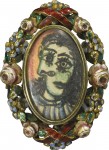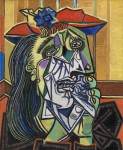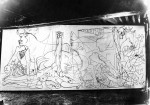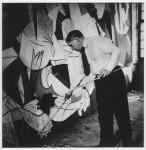 A portrait ring made by Pablo Picasso for his mistress Dora Maar is going up for auction on June 21st at Sotheby’s and is estimated to sell for as much as half a million dollars. The ring’s central medallion is a portrait of Maar, one of many painted by Picasso during their tempestuous affair. It is surrounded by a garland of flowers wrapped in ribbons made of colored enamel mounted on a ring of yellow gold.
A portrait ring made by Pablo Picasso for his mistress Dora Maar is going up for auction on June 21st at Sotheby’s and is estimated to sell for as much as half a million dollars. The ring’s central medallion is a portrait of Maar, one of many painted by Picasso during their tempestuous affair. It is surrounded by a garland of flowers wrapped in ribbons made of colored enamel mounted on a ring of yellow gold.
The relationship between Picasso, 20 years Maar’s elder, and the talented surrealist photographer and artist, was one of the most intense and artistically inspiring of his life, and that’s saying something because he had many lovers/muses over the years. Her hands, whose long, tapered, elegant fingers were reputed to be of particular beauty, and their adornment were at the center of several pivotal episodes in her relationship with Picasso.
 Their first meeting (that he recalled; she remembered meeting him once before but apparently she didn’t make a strong enough impression on him that time) was in January of 1936 at the Café des Deux Magots in Paris. Dora Maar was sitting at a nearby table, stabbing a knife between her begloved fingers. More than once she missed the gap and cut herself, her blood mingling with the red embroidered flowers on her black gloves. Enchanted by the fearlessness and boldness of her self-destructive game, Picasso asked his friend Paul Eluard to introduce him to this raven-haired, blue-eyed beauty. He asked her if he could keep the cut and bloodstained gloves so they could take their place among the beloved mementos in his cabinet of curiosities. She agreed.
Their first meeting (that he recalled; she remembered meeting him once before but apparently she didn’t make a strong enough impression on him that time) was in January of 1936 at the Café des Deux Magots in Paris. Dora Maar was sitting at a nearby table, stabbing a knife between her begloved fingers. More than once she missed the gap and cut herself, her blood mingling with the red embroidered flowers on her black gloves. Enchanted by the fearlessness and boldness of her self-destructive game, Picasso asked his friend Paul Eluard to introduce him to this raven-haired, blue-eyed beauty. He asked her if he could keep the cut and bloodstained gloves so they could take their place among the beloved mementos in his cabinet of curiosities. She agreed.
 That was the beginning of their relationship. He already had a wife (Olga Kokhlova, estranged) and a mistress (Marie-Thérèse Walter) who had recently given birth to his daughter (Maya) whom he was keeping in an apartment. He kept seeing Marie-Thérèse even as his relationship with Dora Maar intensified. Dora was an important part of Picasso’s personal and artistic life during the fecund period between 1936 and 1945. (His catalogue lists more than 2,200 works made over those nine years.) She’s the one who suggested who move into the studio at 7 Rue des Grands Augustins, an attic apartment in a 17th century palazzo once owned by the Dukes of Savoy, where many of his greatest works would be painted. She was the model for The Weeping Woman, a subject Picasso returned to over and over, ultimately creating more than 60 versions of it, the last and most famous of which is now on display at the Tate Modern.
That was the beginning of their relationship. He already had a wife (Olga Kokhlova, estranged) and a mistress (Marie-Thérèse Walter) who had recently given birth to his daughter (Maya) whom he was keeping in an apartment. He kept seeing Marie-Thérèse even as his relationship with Dora Maar intensified. Dora was an important part of Picasso’s personal and artistic life during the fecund period between 1936 and 1945. (His catalogue lists more than 2,200 works made over those nine years.) She’s the one who suggested who move into the studio at 7 Rue des Grands Augustins, an attic apartment in a 17th century palazzo once owned by the Dukes of Savoy, where many of his greatest works would be painted. She was the model for The Weeping Woman, a subject Picasso returned to over and over, ultimately creating more than 60 versions of it, the last and most famous of which is now on display at the Tate Modern.
 It was Dora who photographed Guernica during the month between May 11th and June 4th that Picasso spent furiously painting the monumental tribute to the horrors of war. At the behest of Christian Zervos, founder of the literary and art journal Cahiers d’Art, Maar took dozens of pictures capturing the seven main stages of the painting’s evolution. Through her photographs, you can see how Picasso’s vision developed as he progressed from outline to painting, how some of the most recognizable elements — the bull, the horse,
It was Dora who photographed Guernica during the month between May 11th and June 4th that Picasso spent furiously painting the monumental tribute to the horrors of war. At the behest of Christian Zervos, founder of the literary and art journal Cahiers d’Art, Maar took dozens of pictures capturing the seven main stages of the painting’s evolution. Through her photographs, you can see how Picasso’s vision developed as he progressed from outline to painting, how some of the most recognizable elements — the bull, the horse,  the figure with the lamp, the person with arms raised, the dead soldier, the mother holding her dead child — were on the canvas from the beginning, but the artist altered their positions and proportions as he worked. That’s what he liked about Maar’s photographs, that together they captured the metamorphosis of creation, not a logical progression of steps.
the figure with the lamp, the person with arms raised, the dead soldier, the mother holding her dead child — were on the canvas from the beginning, but the artist altered their positions and proportions as he worked. That’s what he liked about Maar’s photographs, that together they captured the metamorphosis of creation, not a logical progression of steps.
The story of the ring takes place around this time. James Lord, an American art critic and close friend of both Pablo Picasso and Dora Maar, described the event in his 1993 biography Picasso and Dora: A Personal Memoir:
“Dora and Picasso one day were strolling on the Pont Neuf, they had a bitter altercation in the course of which the artist reproached his mistress for having prevailed on him to give a work of art in exchange for a bauble (a cabochon ruby set in a gold and agathe ring), whereupon Dora took the ring from her finger and threw it into the Seine, silencing her lover. She later regretted having been so impulsive. A few months afterwards, the riverbed at that spot was being dredged, and for several days Dora haunted the spot, in hopes of recovering her ring. But it was lost for good. And through Picasso’s fault […] she kept at him until he created a ring of his own design for her.”
That kind of blow-up was far from rare in their relationship. Picasso could be mean as a snake, and tormenting his lovers was one of his favorite hobbies. Dora was hot-tempered and easily provoked into high emotion. While he respected her great intellect and artistic talent, Picasso also took pleasure in pushing all her buttons. In 1943, he met Françoise Gilot, a woman 40 years his junior, and she became his latest mistress. He didn’t end his relationship with Dora (or Marie-Thérèse, for that matter), but it was increasingly fraught with tension and conflict.
 They remained lovers for the duration of World War II, never living together but always in close physical proximity, whether traveling or living in Paris under the Nazi occupation. Picasso was under constant surveillance by the Nazis and his studio was searched repeatedly, but he derived a significant benefit from his fame, his Spanish nationality and, frankly, his money. As a “degenerate artist” who had become increasingly involved in anti-fascist causes starting with the Spanish Civil War, he could have very well have ended up dead or deported. He was too big to be easily dispensed with, however, and Dora Maar, a long-time committed Communist, union sympathizer and, rumor had it, the daughter of a Jewish father, managed to dodge the Nazi killing machine too, probably because of her association with Picasso.
They remained lovers for the duration of World War II, never living together but always in close physical proximity, whether traveling or living in Paris under the Nazi occupation. Picasso was under constant surveillance by the Nazis and his studio was searched repeatedly, but he derived a significant benefit from his fame, his Spanish nationality and, frankly, his money. As a “degenerate artist” who had become increasingly involved in anti-fascist causes starting with the Spanish Civil War, he could have very well have ended up dead or deported. He was too big to be easily dispensed with, however, and Dora Maar, a long-time committed Communist, union sympathizer and, rumor had it, the daughter of a Jewish father, managed to dodge the Nazi killing machine too, probably because of her association with Picasso.
 In 1946, they broke up for good. Dora had a nervous breakdown and was hospitalized in a psychiatric ward for a few weeks, receiving electro-shock therapy. She then went into a private facility where she was treated by eminent psychiatrist Jacques Lacan. When she emerged again, she withdrew from her once-vibrant social life, focusing on her art and becoming a devout Roman Catholic. She and Picasso stayed in touch over the years. They became the weirdest, creepiest pen pals you can imagine, exchanging bizarre gifts. Picasso sent her a chair made of steel tubes and rough-hewn hemp rope. She sent him a rusty shovel, which he loved, by the way.
In 1946, they broke up for good. Dora had a nervous breakdown and was hospitalized in a psychiatric ward for a few weeks, receiving electro-shock therapy. She then went into a private facility where she was treated by eminent psychiatrist Jacques Lacan. When she emerged again, she withdrew from her once-vibrant social life, focusing on her art and becoming a devout Roman Catholic. She and Picasso stayed in touch over the years. They became the weirdest, creepiest pen pals you can imagine, exchanging bizarre gifts. Picasso sent her a chair made of steel tubes and rough-hewn hemp rope. She sent him a rusty shovel, which he loved, by the way.
One of his “gifts” never made it to her. It was discovered by a Canadian doctor when he was going through Picasso’s stuff in 1983. Still wrapped, it was labeled “pour Dora Maar.” The doctor tried repeatedly to contact Dora so he could finally deliver the long-delayed gift, but she never answered him. I’m guessing she knew it was something twisted in there and didn’t want any part of it. If so, she was certainly right. When the doctor opened the present he found a ring “resembling a flat signet ring with the engraved initials P-D [Pour Dora] but to my absolute amazement and horror, I found attached on the inside of the signet a large SPIKE! Thus it was absolutely impossible for anyone to wear it! I thanked my lucky stars for her refusing to accept this ‘gift’ from Picasso.”
How sick is that? I imagine it had to be at least in part a reference to the great Seine ring-toss incident that led to the creation of the portrait ring.
Dora Maar died in 1997 at the age of 89. After her death, her belongings were found to include pretty much every single scrap of everything that had come in contact with or was related to Pablo Picasso — chairs he had sat on, a scrap of paper with his blood on it, newspaper clippings, paintings and artworks, and one portrait ring. The ring was sold at the 1998 estate auction along with her large and seminally important collection of Picasso paintings. The buyer at that sale is the current owner putting the ring up for auction at the end of the month.
Many thanks. Your post was well written and helpful.
How fascinating that it was Picasso who was enchanted by the fearlessness of an unknown woman’s self-destructive game. Dora Maar might have been a beautiful woman, but her behaviour was lunatic! What was Picasso thinking?
Great story as usual, but how do you explain that a Sotheby’s hand was able to wear the so-called unwearable ring :facepalm: ?
The unwearable ring was never delivered. It was made long after the demise of their relationship and found a decade after Picasso’s death among his belongings. The portrait ring was made and given to Dora Maar in the 1930s.
My guess would be that the current owner had the spike removed so the ring could be worn. After all, it may have resembled a ring but until it was able to be worn it was not a ring.
Like sejomoje notes, the spiked ring and the portrait ring are two different pieces made decades apart.
The man was sick – at least that is the charitable interpretation. There is good evidence in his own statements and those of his early circle that it was more of a conscious destructive spirit or zeitgeist. His so-called art is mostly utter rubbish and the prattling about it mostly self-interested cant. If the ‘confession’ written by Giovanni Papini is not Picasso’s, it nonetheless sums up his case perfectly. Time to awaken from the childish fantasy that this is ‘art’ to be compared to a Rembrandt or a Michelangelo. Or admire the Emperor’s amazing clothes a little longer you wish!
It never fails to amuse me how many people are convinced that their viewpoints are facts instead just another opinion.
Well, is is probably fair to assume that Mr. Picasso was indeed an artist – which, of course, does not necessarily mean that you need to like all of his stuff.
Yesterday afternoon, however, I saw an Asian woman approaching me in a runners dress. She clearly did not appear to have been a professional runner. Less than two meters behind her, disturbingly, there was an Asian gentleman, running in a ludicrously crouched posture – until I noticed in passing that he was holding a little camera.
Ever since then, now, I wondered, what on Earth I could have become witness of :confused: , and -coming to terms with it- “Art” could be a satisfying explanation.
Bravo, sir. And you having been witness to this curious display might have placed it in the category of performance art even before the finished product has been uploaded to YouTube (or the inevitable fetish website). 😆
JD, Rick;
The signet ring w the spike and the enameled portrait ring pictured above are two different rings. The ring with the spike was perhaps even more of an “artwork”, sounds like.
Bingo. I think it was a heavily laden message to his former lover, just like all his gross and disturbing gifts to her.
I knew I wasn’t a big fan of Picasso’s art. Now, I know I’m not a big fan of the man. Interesting article though~
He was cruel to her, there’s no other word for it.
:ohnoes: YUK! I can admire some of his work, but would not have enjoyed being in the same room with him, much less a part-time consort.
Indeed! But of course that has nothing to do with the artistic merit if any of a childish daub of a woman’s face with two noses and an offset eye that would not even be considered decent grafitti but for a signature that causes some people to suspend whatever ability to think critically they may possess.
It’s so much easier to go along with the crowd and pretend to be one of the cognoscenti who is able to see the emperor’s amazing clothes.
On holiday in Barcelona with a friend, we made a point of visiting the Museu Picasso. I must confess our reaction was somewhat low-key: OK, been there, done that. We were far more enthused by the various examples of Gaudi’s works. That said, appreciation of Art is very much a subjective, personal, thing.
Gaudi one can respect: one of the very few to create his own architectural style and a style indeed, not just another rehash of geometric blobs and impractical, extreme shapes whose main purpose is a usually futile attempt to be different regardless of cost, function, or maintenance.